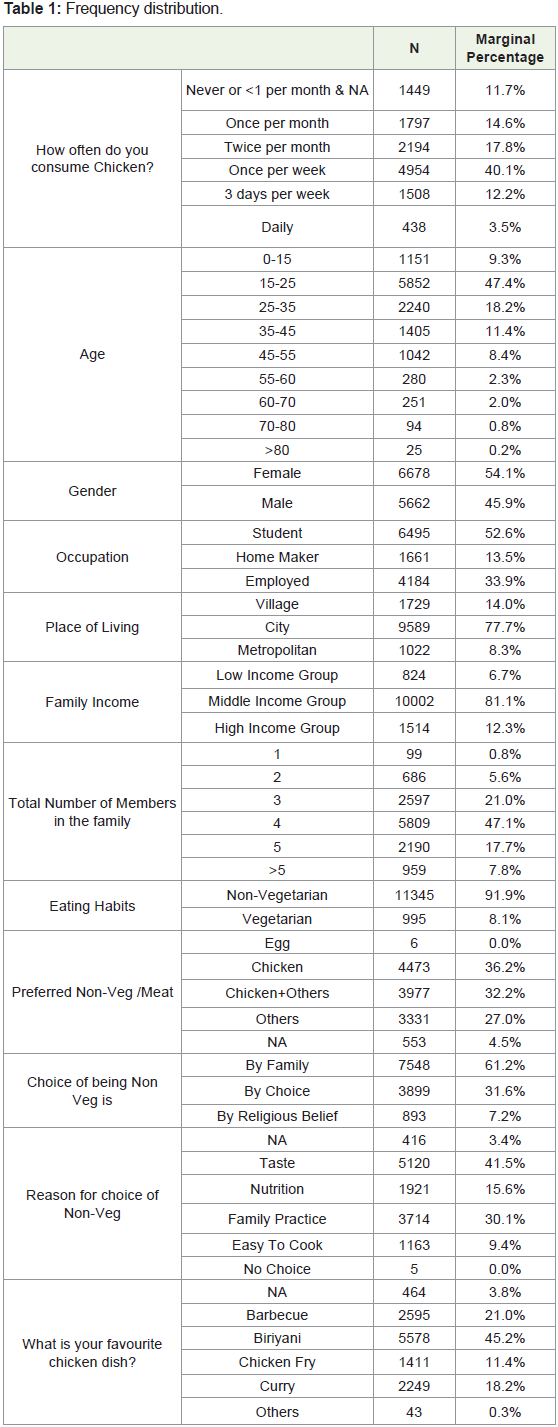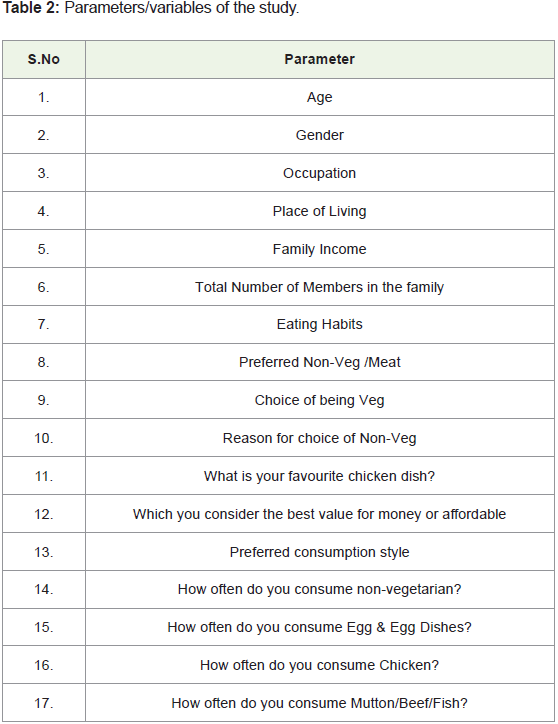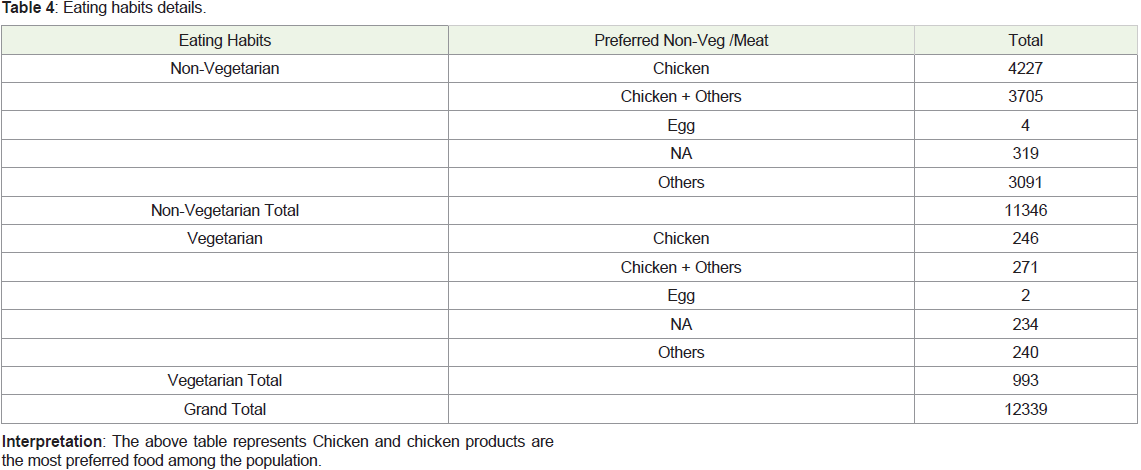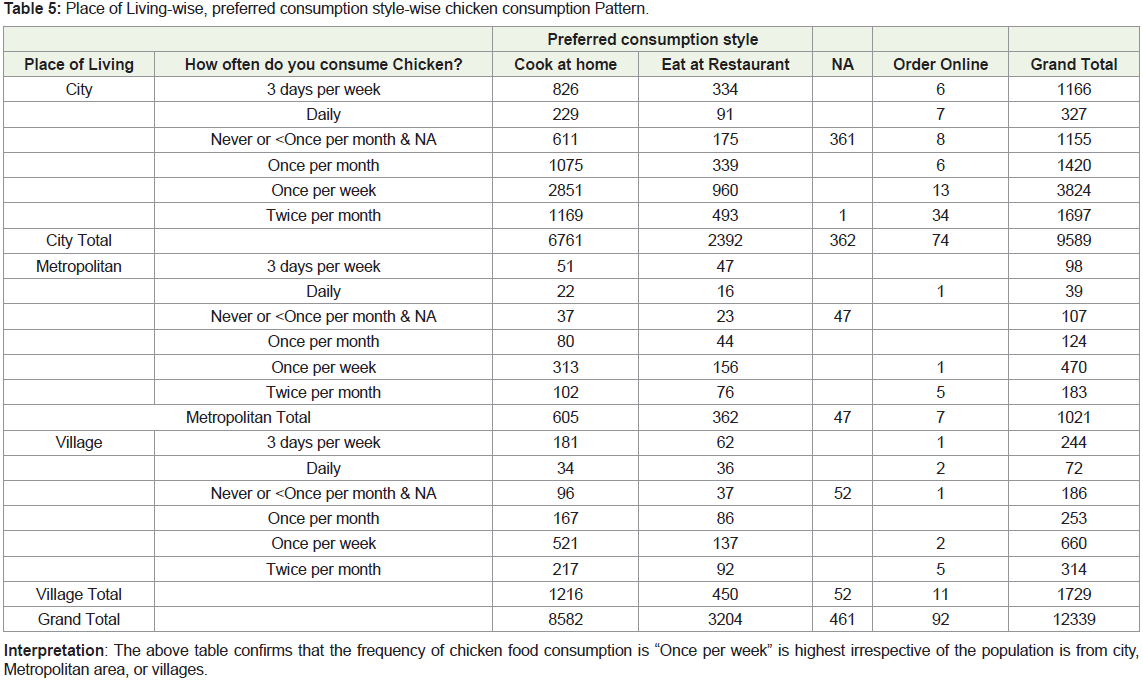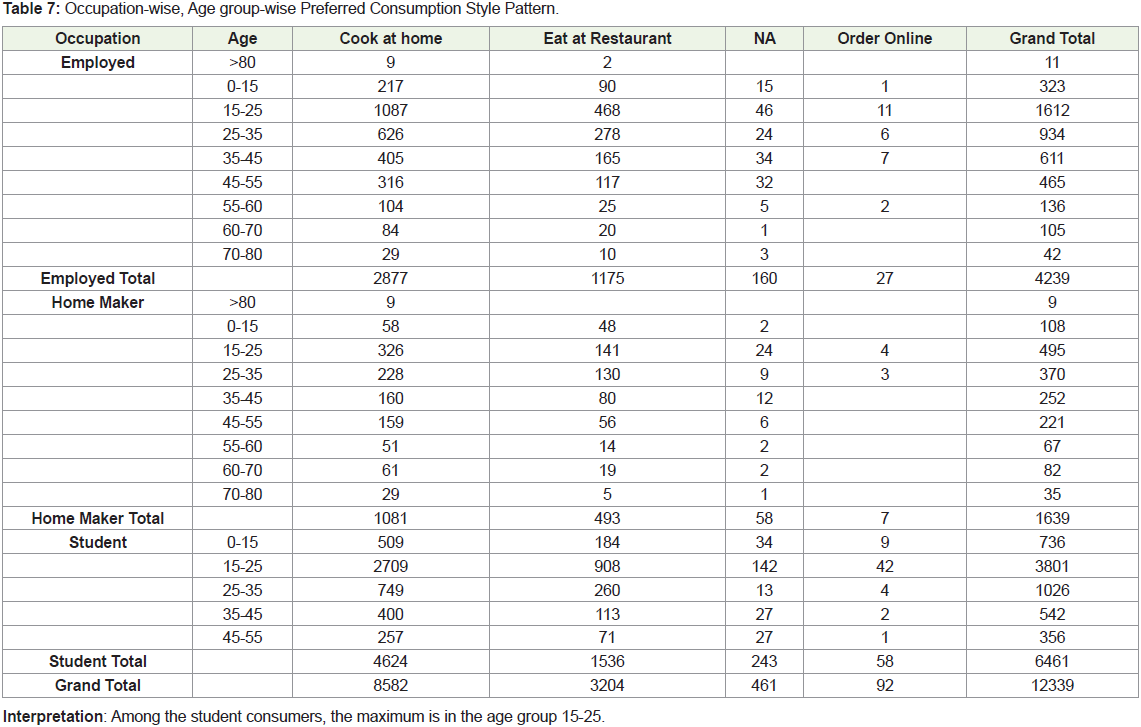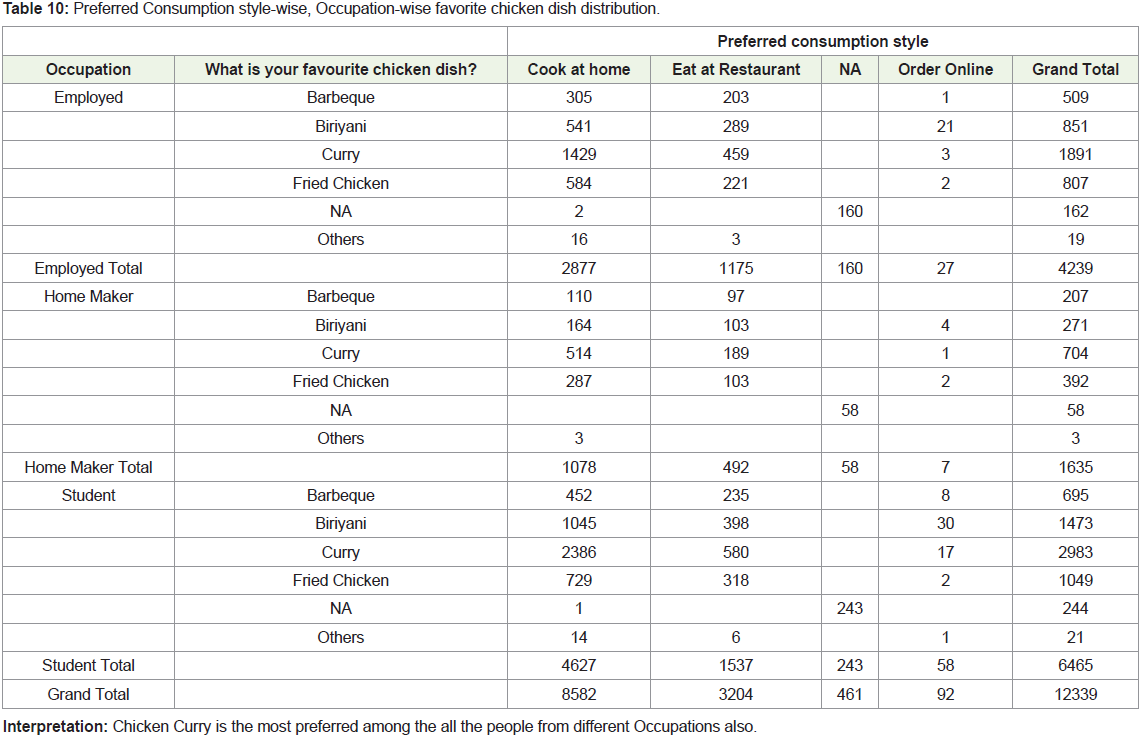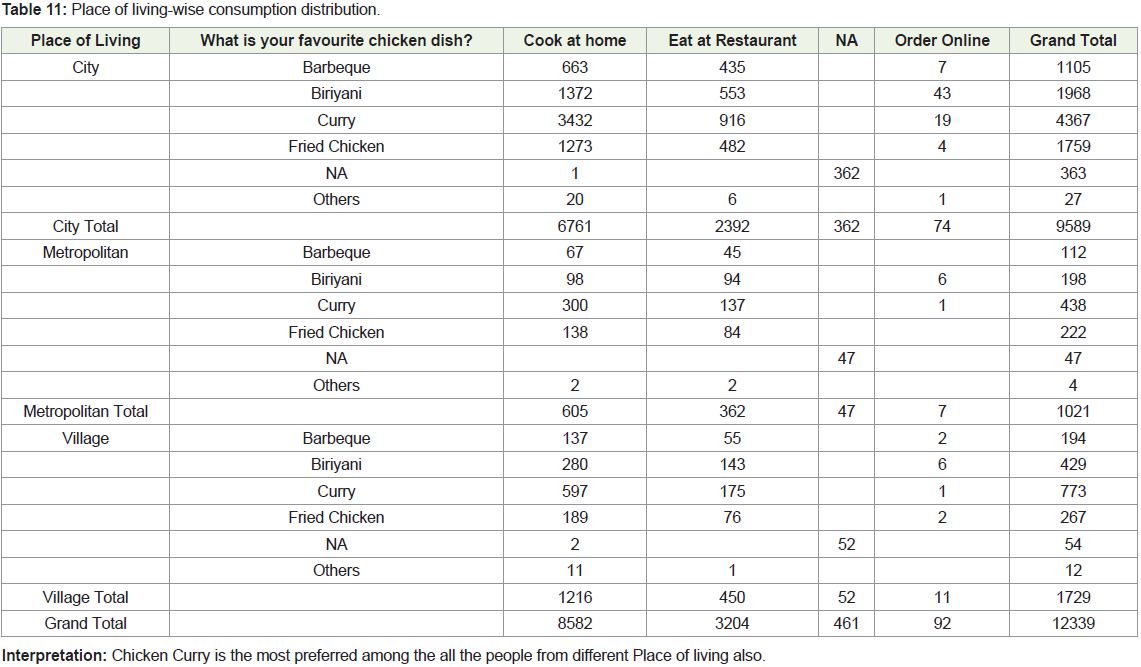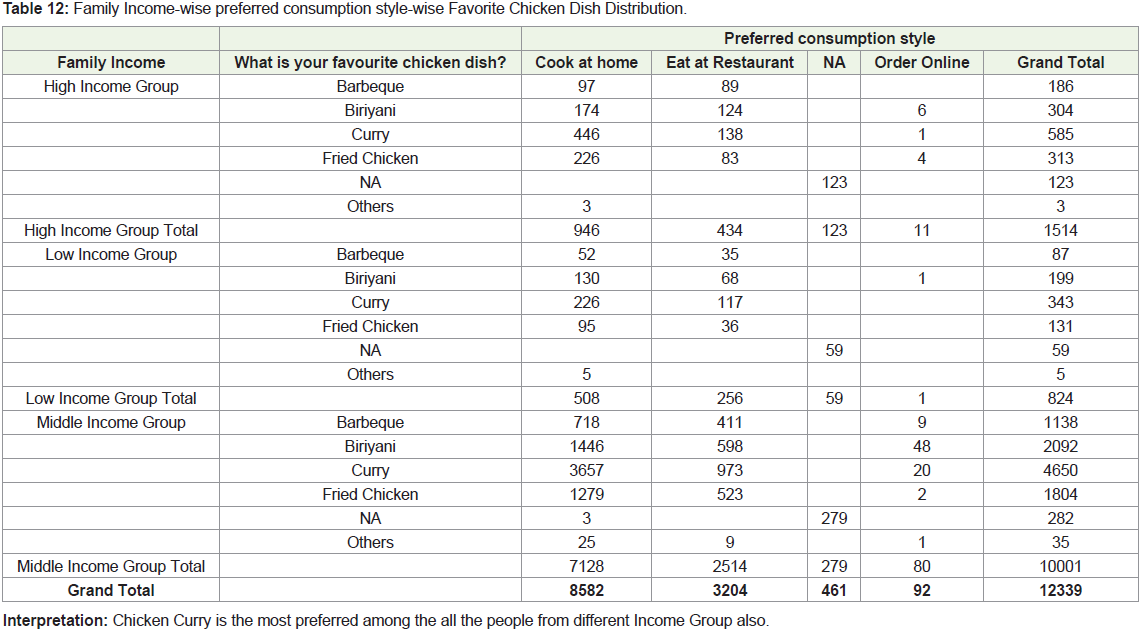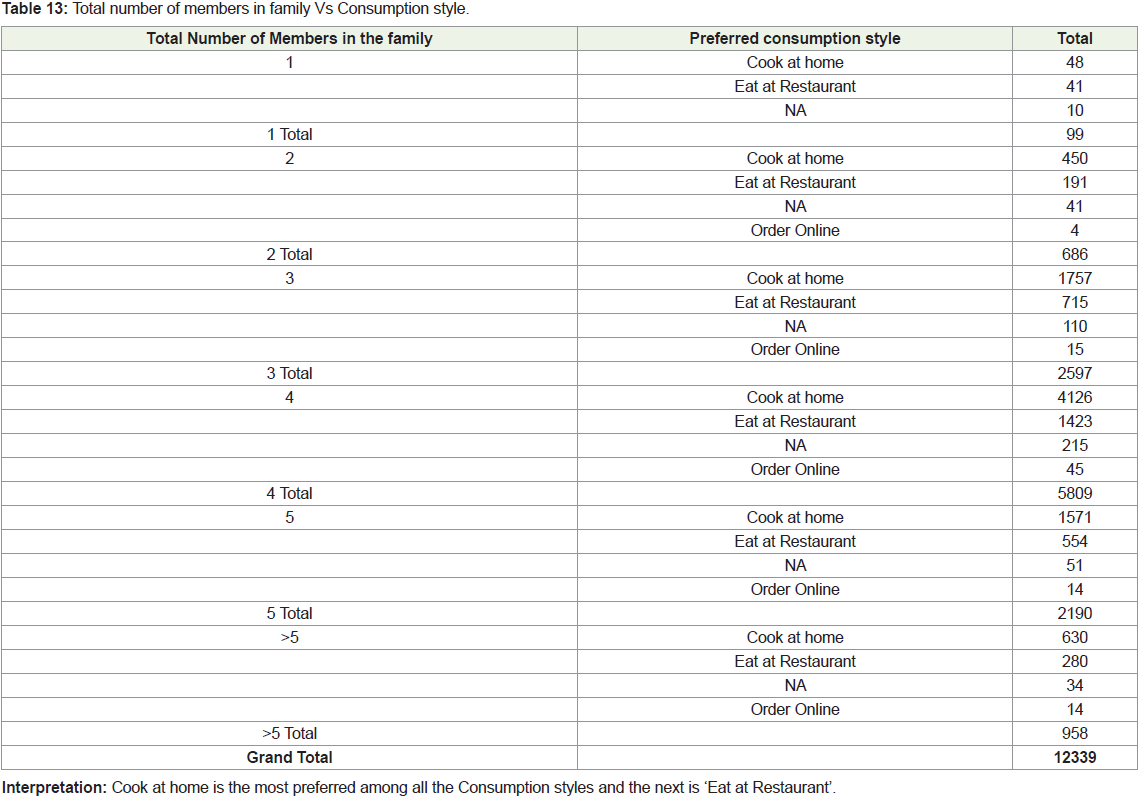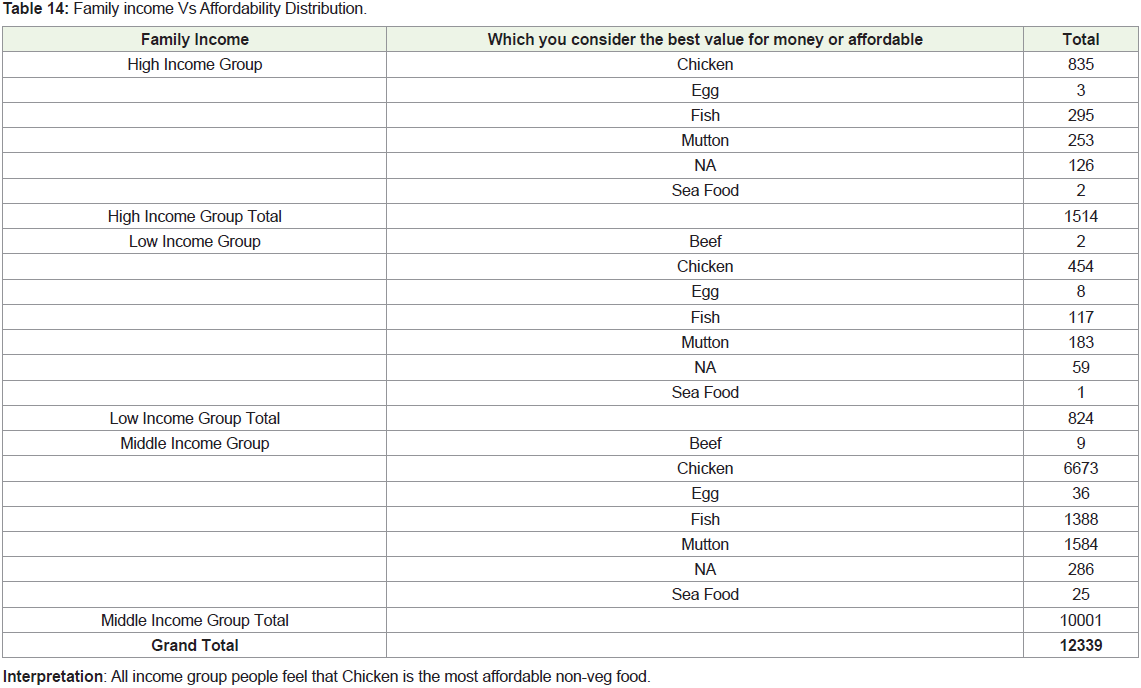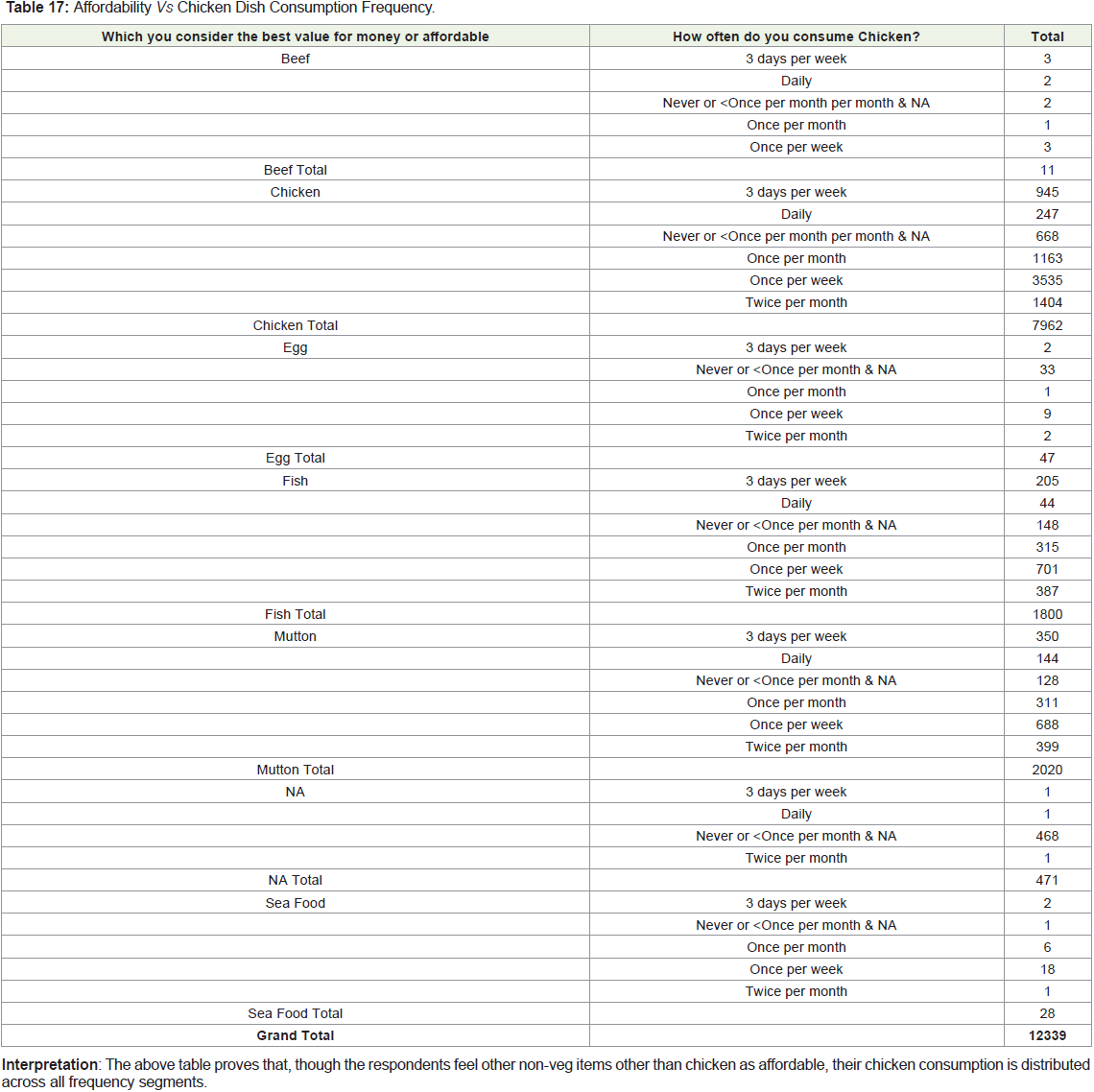Review Article
Factors Influencing Poultry Food Choices - an Empirical Study
Subashree A*
Assistant Professor, Faculty of Management Sciences, Sri Ramachandra Institute of Higher Education and Research (A Deemed
University part of Sri Ramachandra Medical College & Hospital), Chennai, India
*Corresponding author: Subashree A, Faculty of Management Sciences, Sri Ramachandra Institute of Higher Education and
Research(A Deemed University part of Sri Ramachandra Medical College & Hospital), Chennai, India; E-mail: drsubashreea@
gmail.com
Article Information: Submission: 11/02/2022; Accepted: 13/03/2022; Published: 15/03/2022
Copyright: © 2022 Subashree A. This is an open access article distributed under the Creative Commons Attribution License, which
permits unrestricted use, distribution, and reproduction in any medium, provided the original work is properly cited.
Abstract
The research was undertaken to evaluate the poultry products consumption habits and practices of Indians. The objective of the study was to gain an
insight into the fact that given that poultry meat is globally more popular than other forms of meat complimented with the high nutrient quality of poultry products
over other forms of animal food, what are the factors that influence consumption of such food, and what strategies are needed to promote the consumption
of such food that would contribute to enhancing the nutrient quality of general food habits of Indians. The overall macro context of this study was the huge
disparity in the production and consumption of poultry products. Due to innovations and developments in poultry breeding techniques, there has been a huge
increase in the production of eggs and broiler chicken. However since such output is not matched with increase in poultry food consumption, there has been a
glut in the supply of poultry products. This has led to unremunerative pricing for poultry farmers affecting the livelihood of poultry producers who are a vital part
of a nation’s agrarian economy. This research paper examines this disparity from a consumption point of view and analysis the prevalent poultry food choices
and the factors that influence such practices.
For this purpose, a total of 12,339 valid responses were collected spread across diverse demographic, geographic and cultural patterns of the population.
The fundamental finding of the research was that poultry products predominantly as eggs and chicken were the most preferred non-vegetarian food over other
forms of animal food. The study did not find much evidence of other poultry products such as ducks, geese, turkey, etc. The study revealed that the largest
consumers of poultry food were the young population in the 15-25 age bracket coming from urban areas from middle-class family backgrounds. It revealed
that at least 70% of consumers preferred home-cooked egg and chicken dishes over dining them at restaurants. The different forms of egg and chicken
dishes were also analyzed to find out the most preferred menu of such food. The study revealed that while egg and chicken were not part of the staple diet of
any segment of the population, consumption levels were skewed in favor of preferring such food at least 2-3 times a week. The respondents predominantly
preferred poultry food for their taste, affordable costs, ease of cooking and, high nutritive value, in that order. Other than some minor cultural/religious factors
there were no major inhibitions against the consumption of eggs and chicken. Interestingly it was also found that respondents who claimed themselves to be
vegetarians were also egg eaters, if not chicken.
Keywords
Poultry eating; Poultry consumption; Theory of reasoned action; Poultry consumption style; Poultry eating frequency
Introduction
India today is one of the world’s largest producer of eggs and
broiler meat. The poultry industry in India has undergone a major shift
in structure and operation during the last two decades transforming
from a mere backyard activity into a major industry with the presence of a large number of integrated players. This transformation has
involved a sizeable investment in breeding, hatching, rearing, and
processing activities.
Poultry products are proven to be the single, cheapest, and highest
source of all proteins and nutrients required by people of all ages [1]. Poultry meat is highly nutritive, sumptuous, and highly digestible
with very low-fat content. The egg is considered a standard relative to
other sources of protein, be it animal or plant. It is in fact, a balanced
diet [2,3]. One of the most consumed foods which contribute to the
high energy level is poultry food [4]. There is always an increase in
the consumption of poultry products seen year after year throughout
the world. Relatively low sales prices of chicken meat, in comparison
to other types of meat, speak in favor of the increased chicken meat
consumption.
Poultry products like eggs and chicken are proven to be the
single, cheapest, and highest source of all proteins and nutrients
required by people of all ages [1]. Poultry meat is highly nutritive,
sumptuous, and digestible with a very low-fat content. The egg is
considered a staple diet and a high source of rich protein relative to
other sources, particularly in developing countries. Eggs represent
a wholesome and balanced diet [2,3]. Again, poultry intake is one
of the richest sources of human energy [4]. While there has been
increasing in the consumption of poultry products globally, the
challenge is that production and supply far outstripped demand. This
has led to a serious glut in the supply of poultry products leading
to unremunerative pricing for poultry farmers. This has seriously
impacted the global poultry industry which is a significant segment of
the world agrarian economy.
Rationale of Study
Among the many factors that have led to the tepid growth
of poultry, consumption is a factor of growing campaigns for
vegetarianism in the world. More and more people are switching to
vegan diets in the interest of health and fitness. Even non-vegetarians
are shunning chicken meat and are confining themselves to an
eggetarian diet. Besides, factors like the bird flu pandemic of the 1990s
had created a serious image-scare in the minds of the poultry eaters
which continues to persist to this day in the covid era. Such a serious
impact is proven by the fact that UAE and Gulf countries which are the
largest markets for Indian poultry have banned the import of poultry
products from India for more than five years which has only now
been lifted in January 2022 [15]. Other immoral breeding practices
like steroid drugging of poultry feeds have created a serious scare
in the consumption of poultry products amongst the highly health-conscious
western nations. Some specific cultural myths like poultry
intake on the puberty attainment of female children in countries like
India have also discouraged the consumption of poultry products and
its consequence.
However, the global poultry ecosystem has witnessed enormous
changes and improvements by which many of the negative factors
surrounding poultry production have been addressed. The scare of
the bird flu is now well behind us which has restored confidence in
the minds of poultry consuming public more specifically in the highconsuming
nations of the Middle East and Europe. Innovations and
technological aids in poultry genetics have considerably increased
the quality of poultry output. Organizations like the FAO and the
National Action Plan for Egg & Poultry in India have prescribed strict
standards and supervision of poultry production in India, particularly
amongst SME poultry farmers in Tamil Nadu and Maharashtra which
are the major poultry producing centers in India.
Given the above scenario, there is now an urgent need to renew
and restore consumption levels of poultry products particularly in
high poultry producing countries like India. The poultry regulatory
and government agencies have launched campaigns to highlight the
nutrient potential of poultry products. There is a widespread belief
amongst the health-conscious that red meat like beef and mutton
are high-risk foods contributing to cardiac diseases. On the contrary
chicken meat is considered far healthier and more nutritious and
does not have the risk of red meat. In the post-pandemic era, there
is greater consciousness amongst people to increase consumption
of chicken and eggs considered to be the richest source of proteins
so essential for recovery from after-effects of the corona. A recent
development has pointed out that vitamin B12 deficiency is the reason
for the poor nutrition health of the large veteran health of Indians.
No other vegetable or other source has the presence of Vitamin B12
which is richly present in egg whites and chicken meat sources or
predominantly vegetarian many of the corona related illnesses. There
is therefore in this scenario an urgent need to revive and boost the
consumption of poultry products and in this context understand the
factors that influence the consumption of poultry products.
It is with the objective that this research has been undertaken
to clearly understand the current poultry consumption habits and
practices amongst Indians and therefore gain insight on the steps
that can be taken to boost the consumption of such products both
in the overall interest of the industry an more specifically improving
the overall nutrition quality of the young population. By 2023 India
is said to have the largest population of Millennial in the age group of
15-25 which will form the backbone of the Indian workforce. This age
group incidentally is also the highest consumers of poultry products
and this research has focused largely on understanding the current
practices and needs of this segment of the population to have a more
healthy and nutrient-rich producing workforce.
Review of Literature
In 1999, global production of chickens reached 40 billion, and by
2022 this trend is expected to continue to grow so that poultry meat
will become the consumers’ first choice [6,7]. In addition, chicken
meat is known for its nutritional quality, as it contains a significant
amount of high-quality and easily digestible protein and a low
portion of saturated fat. Therefore, chicken meat is recommended for
consumption by all age groups [5]. Fresh chicken meat and chicken
products are universally popular. This occurrence can be explained
by the fact that this meat is not a subject of culturally or religiously
set limitations, and it is perceived as a nutritionally valuable foodstuff
with low content of fat, in which there are more desirable unsaturated
fatty acids than in other types of meat [8,9]. More importantly,
quality poultry products are available at affordable prices, although
their production costs may vary [10]. If referring to the overall
consumption of all types of meat, poultry meat consumption takes
one of the leading places in all countries throughout the world [5].
Income increase over some decades has resulted in increased poultry
and meat consumption [7].
Easy cooking is also a consideration for poultry meat being more
popular among consumers [11]. Comparisons of Irish consumers’ beliefs about pork and poultry in the framework of Theory of
Reasoned Action (TRA) showed that poultry is viewed as the tastier,
healthier, and less expensive of the two types of meat while pork is
viewed as the safer meat. The influence of attitudes and intention
to consume these meats was explored and the findings support the
basic structure of the TRA model [12]. Religious belief influences the
consumption of poultry products in villages [13].
A strong but unfounded perception against consumption
of poultry products is that of the poultry industry indulging in
administeringhormones, steroids etc to beef up breeding and
production. But the truth is that no hormones are used in poultry
production. Even though the truth speaks for itself, the poultry
industry must be vocal if we expect the message to be heard, according
to Dr Tom Tabler (Extension Professor), Jessica Wells (Extension
Instructor) and Dr Wei Zhai (Assistant Research Professor, Poultry
Science) of Mississippi State University Extension Service. The World
Health Organization (WHO) has identified certain environmental
contaminants as a global concern. These contaminants are capable
of harming reproduction and development by altering endocrine
functions in humans and wildlife. As the human population grows
and livestock production becomes more concentrated, the quantity
and concentration of hormones within local areas increases.
As a result, many in the poultry field hear the same question
with increasing frequency: “Why do you put hormones in the feed
to make chickens grow so big and fast?” The fact that the question
begins with “why” instead of “do” indicates the level of confusion
and misunderstanding of the consuming public. The truth is no
hormones have been allowed in poultry production for more than 50
years. Hormone use in poultry production was banned in the United
States in the 1950s. Some of the confusion and misunderstanding
may stem from the fact that the poultry and beef cattle industries
operate under different regulations. While growth hormone use is
banned in poultry production, it is a perfectly legal and accepted
practice in the beef cattle industry. Unlike poultry (which receive no
added growth hormones), most beef cattle fed in the United States
do receive a growth-promoting hormone implant, usually when they
enter a feedlot.
Therefore, like insulin in humans, growth hormones given to
chickens would have to be injected to be effective. And to further
complicate matters, research indicates that, to be administered
successfully, chickens would need to receive growth hormone
injections several times each day (Czarick and Fairchild, 2012).
This undertaking is logistically impossible. Most broiler growers
have 20,000 or more chickens in each house and numerous houses
on the farm. There is no way to catch each chicken in every broiler
house numerous times a day and give it a hormone injection.
Besides, modern broilers have been genetically selected by primary
breeder companies to grow to their physiological limit. The fact is, chickens grow as fast as they should naturally, without the use of
growth hormones. Additionally, using hormones to force chickens
to grow too quickly would cause increased leg problems and even
early death. The poultry industry must do a better job of providing
factual information to consumers to combat the confusion, myths
and inaccurate information that has become so prevalent regarding
hormone use and chicken production. The truth is no hormones are
used in poultry production. And even though the truth speaks for
itself, the poultry industry must be vocal if we expect the message to
be heard [18].
Objectives of the Study
• To understand the tastes of poultry eaters
• To understand the poultry eating habits among various
sections of non-Vegetarian eaters.
Methodology
The food frequency scale was derived from Nirdnoy, et.al [14].
20,000 questionnaires were circulated across India, from zero to 80+
years. 15,309 responses were received and 12339 valid responses were
considered for analysis.
Reliability analysis was carried out to check the validity of the
questions asked. As the primary objective was to find out the poultry
consumption pattern, Microsoft-Excel was used to analyze the data to
arrive at different patterns.
Responses represent well dispersed across consumption
segments, age groups, geographies, locations, social status, etc. A total
of 17 parameters, as shown in Table, were used to assess consumption
patterns.
Data Analysis
Frequency distribution:
The parameters used to capture the responses from the
respondents are as given Table 1and 2:SPSS Analysis:
Reliability Analysis” Reliability analysis is done for the specific
food consumption-based questions
How often do you consume non-vegetarian?
How often do you consume Egg & Egg Dishes?
How often do you consume Chicken?
How often do you consume Mutton/Beef/Fish?
Table 3 with the Cronbach alpha = 0 .717 proves the
questionnaire’s reliability.Consumption Pattern Analysis (Table 4-18).:
Findings & Conclusion
The majority of 40% consume chicken once a week, along with
eggs, and are females in the age group of 15-25 being students located
in urban areas. Homemakers consume less than employed. Only 8% of
the respondents were vegetarians. The most preferred non-vegetarian
food is chicken over eggs and other poultry products. Taste is the
preferred attribute for consumers preferring chicken as a food choice.
The most preferred chicken food is biryani over barbecue, chicken
curry, chicken fry, etc. Despite egg being the cheapest alternative, the
chicken was chosen as the best value for money. The most preferred
cooking choice is homemade. Further, it was found that among
vegetarians, the most preferred food was chicken and not egg as
generally presumed.
Consumption patterns were skewed in favor of residents in cities
consuming homemade chicken, as against restaurant dining, at least
once a week. People living in villages were found to be consuming
more frequently at least thrice per week.
Consumption of egg and egg dishes was largely confined to
students cooking at home in cities. Home cooking was the preferred
style for egg and related dishes. Those employed also preferred egg as
a major food consumption item.
Demographic distribution proved that the vast majority of
consumers were in the 15-26 age group and consumption tended
to drastically reduce for increasing age brackets. When preferred
chicken dishes were separately assessed, it was found that the majority
ate chicken curry cooked at home as against other chicken dishes like
biryani, barbecue, chicken fry, shawarma, etc, again at restaurants;
the most preferred choice was also chicken curry than other dishes.
Biryani and fried chicken were the second and third choices. Analysis
proved that the middle-income group is the largest consumers of
chicken dishes followed by high-income and low-income groups.
Therefore, low-income groups in villages have the greatest potential
to increase poultry products. The ideal family size that consumed
poultry products was a husband-wife with a child. Among nonvegetarian
foods in order of preference were chicken, fish, mutton,
and egg dishes.
World poultry meat consumption is constantly growing.
Chicken meat is a source of high-quality protein with a relatively
low content of fat. In poultry production, meat and eggs stand out.
Functional ingredients are supplemented to chicken feed to improve
the nutritional value of chicken meat, thus making chicken meat a
foodstuff with added value (enriched or functional product), as it
contains ingredients that are beneficial to human health [3].
Broiler meat in the past had been considered to be a delicacy
but as a result of increasing levels of urbanization and higher levels
of disposable incomes, poultry meat is increasingly seen as less of
a luxury product and more as a daily staple. Further with changing
food habits and increasing exposure to global cuisines, the Indian
population is increasingly converting to a non-vegetarian diet.
Poultry meat is preferred over other meat products as it is considered
more hygienic and is available throughout the year across the country
at relatively lesser prices than fish/mutton. Further: The annual per
capita consumption of broiler meat and eggs remains one of the lowest in the world and is significantly lower than many emerging
and developed markets [16]. As a result of the low penetration levels
and continuously increasing income levels, however, we expect the
per capita consumption of both broiler meat and eggs to increase
continuously during the next five years. Again the growth in the food
services market such as restaurant and fast food joints are also creating
a positive impact on the consumption of broiler meat and eggs. Both
broiler meats as well as eggs represent important ingredients in both
traditional Indian non-vegetarian recipes as well as fast foods. In
addition, eggs represent an important ingredient in bakery foods
and the Indian bakery foods market is currently exhibiting strong
growth rates. This is expected to create a positive impact on the
consumption of eggs in India [17].

